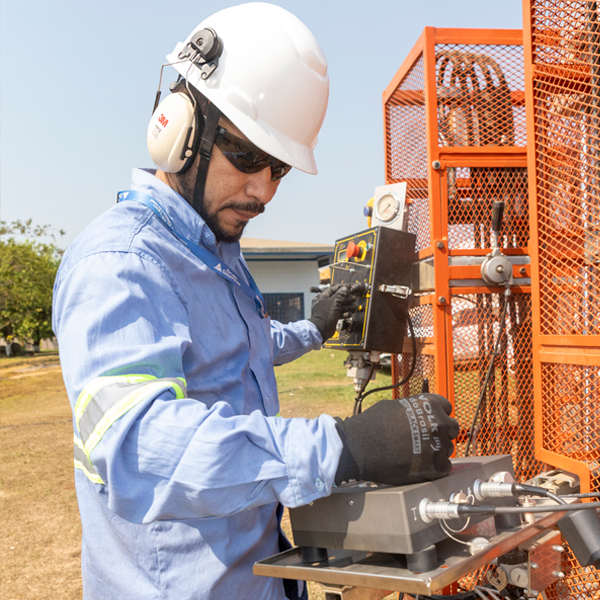DRILLING INVESTIGATIONS
Rotary Drilling
Rotary drilling is performed with mechanical and hydraulic drilling rigs. It is classified as a semi-direct investigation method, since soil and rock samples can be recovered, but in-situ observation of the strata is only possible through the collected cores. Drilling may be carried out using either the conventional method or the wireline system.
Main applications of rotary drilling:
- Collection of soil and rock samples at great depths;
- Identification and classification of soil and rock types along the borehole profile.






Rotary boreholes can also be equipped with instruments such as water level indicators, piezometers, inclinometers, load cells, among others. They also allow the insertion of equipment for in-situ tests, video logging, strength/resistance testing, and related investigations.

Core description provides information on:
- Rock type;
- Degree of weathering;
- Degree of fracturing;
- Rock mass coherence;
- Identification of foliation or schistosity;
- Determination of RQD (Rock Quality Designation), an index of rock mass quality;
- Depth to bedrock;
- Thickness of soil horizons;
- Groundwater level measurement;
- Sampling for chemical and mineralogical analyses, when performed for mineral exploration purposes.
CPT / CPTu / SCPTu – Cone Penetration Tests
The cone penetration test (CPT) is based on advancing a conical tip (60° apex angle) into the ground at a constant rate of 20 mm/s ± 5 mm/s. The cone has a standard cross-sectional area of 10 cm², but may vary between 5 cm² (special conditions) and 15 cm² or larger (high-capacity equipment).
Test procedures are standardized, and equipment can be grouped into three main categories:
- Mechanical cone, where cone resistance (qc) and sleeve friction (ƒs) are measured at the surface through mechanical transfer along the rods;
- Electric cone, fitted with electrical load cells to directly measure qc and ƒs at the cone tip;
- Piezocone (CPTu), which in addition to qc and ƒs, also records pore water pressure (u) continuously during penetration.






When equipped with geophones (SCPTu), the system also records P-wave (compression) and S-wave (shear) velocities, allowing estimation of soil stiffness and deformation moduli.
Key advantages of CPT methods:
•Continuous profiling of penetration resistance, providing detailed subsurface stratigraphy essential for foundation design and cost estimation;
• High penetration rate (~1 m/min);
• Continuous stratigraphic profile at 5 cm (or finer) intervals;
• Standardized, highly reliable testing;
• High accuracy (<1%) and repeatability;
• Automated data acquisition, processing, and plotting;
• Excellent cost-benefit ratio;
• Capability of integrating additional sensors easily.
Mixed Drilling (Percussion + Rotary)
Mixed drilling combines SPT (Standard Penetration Test) percussion drilling in the soil portion with rotary coring in the rock portion.
This method is typically used when SPT testing is required in the soil section of a rotary borehole. Transition from percussion to rotary drilling must occur once SPT refusal is reached, without resorting to water jetting to advance the borehole.









Hand/Mechanical Auger Drilling
Auger drilling is a semi-direct geotechnical investigation method, which allows recovery of soil samples, though in-situ observation is only possible through retrieved material.
It is used to:
• Identify soil type and thickness in the lithological profile;
• Collect disturbed soil samples for description and subsequent geotechnical laboratory testing;
• Measure groundwater levels;
• Install instruments such as water level indicators, piezometers, inclinometers.
Auger drilling can be carried out in two ways:
• Manual auger drilling;
• Mechanical (motorized) auger drilling






Percussion Drilling – SPT (Standard Penetration Test)
The SPT (Standard Penetration Test), also known as percussion drilling or simple reconnaissance drilling, is one of the most widely used soil investigation methods. It is commonly applied in granular soils, cohesive soils, and soft rock formations, particularly in civil engineering projects, to provide essential data for foundation design and bearing capacity assessment.
Information obtained from SPT includes:
- Identification of subsurface soil layers;
- Soil classification of each layer;
- Groundwater level measurement;
- Estimation of soil bearing capacity at different depths.






Manual Inspection Well
This is a type of survey carried out by manually digging wells. In this case, a vertical circular or square pit is opened, allowing for the observation and mapping of the lithological and geotechnical profile of the terrain at that point and the collection of deformed or undeformed samples (undeformed block). These will later be sent to the geotechnical laboratory for testing.




QUALIDADE
We are certified by the main international standards — ISO 9001, ISO 14001 and ISO 45001 —, which reinforce our commitment to quality, the environment, and occupational health and safety, fundamental pillars of our mission to offer efficient, high-performance solutions.
